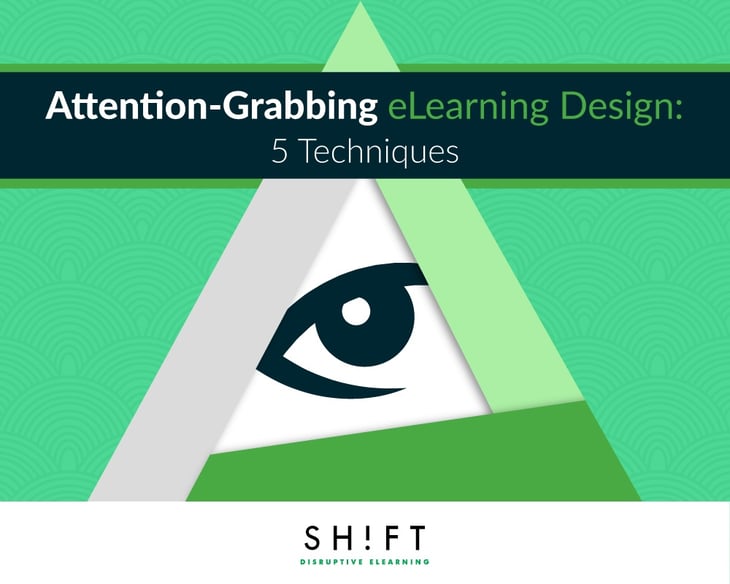Unless you have a phenomenal photographic memory, chances are you struggle to remember things and wonder how you can make information stick better. The answer? PAY ATTENTION! When you pay attention, you are far more likely to retain that information. This also applies to the learners you design eLearning courses for.
Effective eLearning course design starts with understanding the science of attention. Neglecting this important step makes the difference between learner’s remembering your content for a few minutes, hours, or a lifetime.
Try some of these techniques for getting learners’ attention from the get-go:

1) Give Learners a Reason to Pay Attention Right From the Start
A course is not a mystery novel that needs a big reveal at the end, so don’t keep its usefulness a secret or save it for the end. Quite the opposite, you should give students a reason to pay attention from the beginning by telling them how this course is going to help them. If they find it relevant, they will continue.
This concept is called frontload relevance, and it helps students stay focused right from the start versus them zoning out and then trying to play catch-up before an exam. You can accomplish this initial capture of attention by asking yourself what problems your students might have and how the information you are presenting will solve this now or in the future.
Presenting an example, telling a story, or give a quick case study can get the ball rolling easily before you launch into the actual course material. Here are some other strategies for frontloading relevance:
- State and Restate: tell learners the purpose or objective of the course and have them restate it in their own words to increase engagement with the concept.
- Give them a choice: engage students by giving them control over their own learning. This can include letting them choose when they learn, the order in which they take the course, and even the types of learning activities to complete.
- Let them predict: Instead of just stating what will happen in a scenario, give them a chance to predict what will happen in order to engage their reasoning skills and apply what they already know.
- Summarize: Write a summary or overview of the course's section in a few sentences or in a visual way. Include your most important points to be covered.
- Make it realistic: The beginning of your course is not the time to be lofty. Make sure to connect the course to your students’ reality and provide details that will make the information more real than theoretical.
Read: 5 eLearning Design Mistakes That Can Ruin a Good First Impression
2) Make It Useful Right Now
You may need a lot of encouragement to plan for the future, but it’s hard to ignore things that need to be done now, right? By letting students know the information you are presenting is useful right now, you are making it hard to look away from. While you may not be able to have students use what they learn immediately, you can still convey that it will be important very soon.
Humans are naturally inclined to pay attention to immediate dangers for survival, but this is also relevant due to our culture of instant gratification. People need to feel that there is an immediate payoff.
You can create this sense of urgency pretty easily by:
- Giving students limited resources, for example, provide them with a time limit or a deadline to complete the course.
- Offering them something they think it's worth their time ( e.g.: increase productivity at meetings).
- Presenting examples of things that have gone wrong recently and that could be solved with this training.
Also read: 10 Things That Learners Pay Attention To (And How to Use Them in eLearning)
3) Show Them The Big Picture
Have you ever tried to complete a jigsaw puzzle without a completed picture to look at? There is a reason puzzle makers include that picture on the outside and it’s not just because it looks prettier.
It’s easier to work on the puzzle when you can see the whole and easier to make the pieces fit together as you find them. The pieces themselves are more understandable when the whole picture is clear.
Learning is the same way and the whole is more easily remembered when it is presented first and lets learners know what is going to happen to better prepare them for knowing what pieces they need to look for.
We grasp this big picture better than details or individual puzzle pieces, and this is why you need to start with that to grab the learner’s attention right away. For instance, when you start a course it’s a good idea to create a bulleted list of main topics to show students where the course is headed without giving them a bunch of technical info right away.
4) Design with Short Attention Spans in Mind
People simply do not have the attention span they once did. The increasing digitalization of our world has made it far too easy to swipe, click and look away from things because there is always something else to look at. This has led to us having an 8-second attention span [2]. Yes, that is actually one second shorter than a goldfish.
You can design your eLearning courses to appeal to shorter attention spans by following these strategies:
- Design for Fluctuating Attention Spans: While we have focused on grabbing attention, even once you get learners to focus it doesn’t mean they are going to stay focused. Attention naturally fluctuates, and you can design your courses in intervals to follow this inevitable variation. Recapture their attention every 5-10 minutes by shifting the focus of information.
- Make it Skimmable: People rarely read anything word for word and pay the closest attention to the first and last sentence of a paragraph so put main points here along with keywords that will catch their eyes.
- Start with Questions: Use questions in your headers and phrase them as the learner would phrase them. Example: How Can I Know if I Have ADHD? Before a paragraph explaining the symptoms of ADHD.
Recommended reads:
- 4 Tips on How to Convert Long-Form eLearning Courses to Micro Lessons
- How To Avoid Designing Cluttered eLearning Screens
5) Unpredicatability
Predictable things simply won’t hold learners’ attention for too long. Asking questions, telling stories, or switching topics all help to make things unpredictable and more likely to be paid attention to. This doesn’t mean information should be disorganized, but it should be broken up in an unexpected way at times.
This excitement stimulates our dopamine production, which is a compound in our bodies that aids in a variety of brain functions and causes us to want more of something. People typically think of this regarding physical needs, but it is also about abstract or mental concepts. It makes us curious and makes us want to seek out more information.
When you think of how dopamine affects you, consider how you feel when you go to watch one little internet video and end up spending three hours cruising through videos of cats knocking stuff over or random people telling you how to open a can without a can opener. Each new image is releasing a little bit of dopamine and spurring you on to click the next one.
As an eLearning designer, you should focus on figuring out what is going to make your learners click next in your course. Make your concepts real to them and present rewards they can identify with and focus on as a goal.
Unpredictable Audio and Visual Cues
DING! Did just reading that make you think of your phone? Did it make you want to check your phone to see if maybe you did, in fact, miss a text or other notification? Oh, what could it be? There might be something amazing waiting for you on there! You need to go check. Actually, please finish this blog first, thanks!
The unpredictability of what the sounds from your phone could mean is the same kind of unpredictability you want to create for your students because, as you likely know, that sort of stimulation is exactly what is going to have you running to see what’s next. Sounds and sights that signal something new are about to happen to engage our dopamine system and have us seeking more.
Ben Parr, author of ‘Captivology’, says “Violate people’s expectations…you want to have people turn their eyes up a little bit more… we’re attuned to surprises, and we have a pleasant experience with positive surprises.”
As you design your courses always keep your learners in mind and what is honestly relevant to them and what will keep them focused. You can start by asking yourself what you would need to get the most from the course. Design to satisfy this objective and you are well on your way to effective courses.
REFERENCES:
[1] Dirksen, Julie. (2011) Design for How People Learn
[2] Microsoft Attention Span Study
[3] Wilson, D. L., & Conyers, M. A. (2011). BrainSMART: 60 Strategies for Increasing Student Learning. Orlando, FL: BrainSMART.
[4] Weinschenk, Susan.(2013) How to Get People to Do Stuff: Master the art and science of persuasion
[5] Weinschenk, Susan. (2012) 100 Things Every Presenter Needs to Know About People
[6] Medina, John. Brain Rules (Updated and Expanded): 12 Principles for Surviving and Thriving






